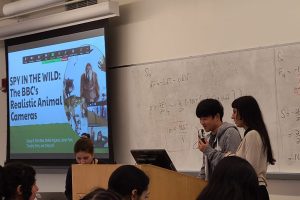
Visual storytelling, or the art of using graphics, images, videos and other visual elements to tell a story through mediums such as charts, illustration, photography, and infographics, is an important part of every discipline. It’s also the basis for the new course, FLM 201 Visual Storytelling Across the Disciplines, offered for the first time this semester.
According to researchers at 3M corporation, 90 percent of information transmitted to the brain is visual and processed 60,000 times faster than text processing. Whether studying science, literature, history, or business, students in FLM 201 discover how visual storytelling can enhance their understanding of complex concepts and help audiences understand their research topic.
Karen Offitzer, director of the undergraduate programs in filmmaking and TV writing in the Lichtenstein Center, created FLM 201 to help students understand the importance of visual storytelling, and to also learn the technical tools to create effective visual stories.
Offitzer said students are now getting all of their information from visual content, whether it’s YouTube or images or advertising.
“It’s vital for students to learn to communicate using visual mediums and to become adept at interpreting information received from them — from memes to police cameras to video-guided endoscopies to specialized cameras used for instant replay and slow-motion analysis,” said Offitzer. “How we gain information and shape the narrative about the world is becoming increasingly reliant on images across all industries and disciplines, so students increasingly need these skills to succeed.”
Students also learn technical skills to develop their own visual stories in the course, using both smartphone technology as well as cameras and lighting from the film department on campus.
“Visual Storytelling Across the Disciplines provides an opportunity to develop proficiency in visual storytelling, such as narrative structure, visual analysis, as well as the foundational technical skills like writing, camera use, lighting, editing and sound, so that they can better communicate and express themselves in any discipline,” Offitzer said. “Competence in visual storytelling helps foster the link between academic disciplines by giving students the tools to interpret and create images within the fields most important to them.”
Guest lecturers visit to describe how visual storytelling is important within their discipline. Scott Sutherland, professor and chair of the Department of Mathematics, recently explained the importance of visual storytelling when working with numbers.
“Visualization of mathematical concepts is often very important in mathematics, both for gaining intuition and enhancing understanding, but also an understanding of the underlying mathematical ideas is critical for creating appropriate visualizations,” said Sutherland. “My talk focused on the notion of functions and ways to represent them graphically. This may sound somewhat mundane, talking about graphs, but you might not think of a representation like ‘New York Bus Journeys‘ as a graph of a function. It is, however, a graph of a function of two spatial variables and a time variable.”
Following Sutherland’s guest lecture, students completed a project that used video to “humanize” data sets and explored how numbers can become more persuasive and relatable when part of a greater narrative.
Kate Levitt, lecturer in the Film and TV Writing program in the Lichtenstein Center, teaches both sections of the course.
Levitt emphasizes teaching students to use cell phones for video and editing so that students are prepared at any time to document or create. “Becoming really adept with using your phone as a camera is like the most important thing you can do. There are so many apps now that you can edit really quality footage, just using your cell phone,” said Levitt. “Something that’s really interesting about the film program on campus, generally speaking, is that we want to empower students to be able to make videos with whatever they have because they will go out into the real world after school and might not have access to film equipment, but will still have the narratives in their head.”
Sam Nadai is a first-year English major enrolled in FLM 201. “It is useful to learn how to use a medium like film or visual art to explore more scientific, typically objective fields, and see how those fields can be affected subjectively by using visual storytelling,” said Nadai.
In conjunction with the course, the Film and TV Writing program introduced a series of Science + Cinema events, in which Stony Brook research professors are paired with a narrative feature film that relates synergistically to their work, and students learn how to separate fact from fiction within the films.
“If you understand how to take something abstract and turn it into a visual narrative, it lends so much more empathy, and you can humanize the topic and make it more relatable,” said Levitt. “No matter what your major is, this class helps students to be able to tell a compelling story, and using visual images is only going to broaden your audience.”
— Beth Squire